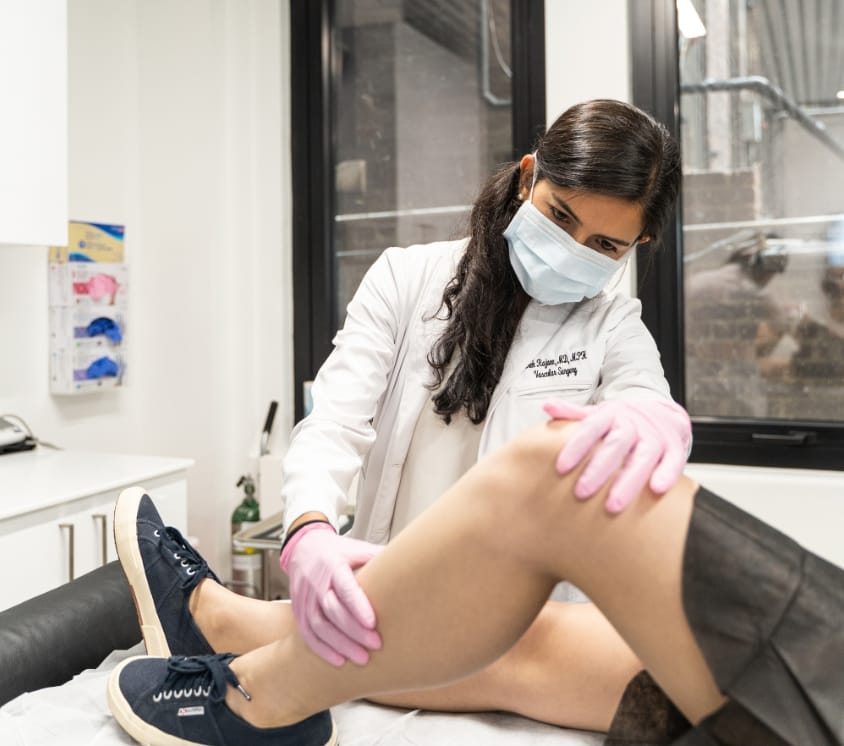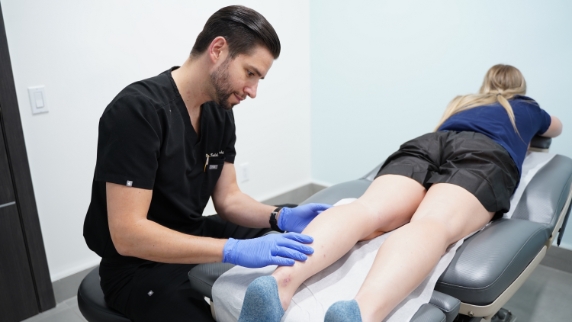You’re getting ready for a day out, and as you slip into your favorite outfit, you notice thin, web-like veins scattered across your legs. You might shrug them off as a cosmetic issue, thinking they’re nothing more than an annoying blemish. But those spider veins could be more than just an eyesore—they could be signaling an underlying vein condition that needs attention.
Spider veins are small, dilated blood vessels that appear near the surface of the skin, often on the legs and face. While they might seem harmless at first glance, they can be a symptom of chronic venous insufficiency, a condition where the valves in your veins don’t function properly, leading to blood pooling and increased vein pressure. Ignoring spider veins could lead to several serious consequences that affect both your health and quality of life.
In this article, we highlight five possible consequences of having spider veins.
1. Chronic Pain and Discomfort
One of the most immediate consequences of having spider veins is chronic pain and discomfort. Although spider veins are smaller than varicose veins, they can still cause significant physical discomfort. You may experience a constant aching or throbbing sensation in your legs, particularly after long periods of standing or sitting. This pain is often exacerbated by the pooling of blood in the affected veins, which increases pressure and leads to swelling and heaviness in the legs. Over time, this discomfort can become a persistent issue, affecting your daily activities and overall well-being.
2. Increased Risk of Varicose Veins
Spider veins may be an early warning sign of venous insufficiency, which can eventually lead to the development of varicose veins. Unlike spider veins, varicose veins are larger, bulging veins that often appear twisted and raised above the skin’s surface. They are not just a cosmetic concern; varicose veins can cause significant pain, lead to skin changes, and increase your risk of more severe complications such as blood clots. If left untreated, spider veins can progress into varicose veins, making early intervention crucial.
3. Skin Ulcers and Infections
Another consequence of untreated spider veins is the development of skin ulcers and infections. Chronic venous insufficiency can impair blood circulation in the legs, leading to skin changes such as discoloration, dryness, and thinning. Over time, this can cause venous ulcers—painful, open sores that are difficult to heal and prone to infections. These ulcers often form around the ankles and can significantly affect your mobility and quality of life. In severe cases, an untreated ulcer may lead to cellulitis, a serious skin infection that requires immediate medical attention.
4. Blood Clots and Deep Vein Thrombosis (DVT)
Spider veins, especially when associated with chronic venous insufficiency, can increase your risk of blood clots. Blood clots in superficial veins, known as superficial thrombophlebitis, can cause pain, redness, and swelling. While these clots are usually not life-threatening, they can lead to more serious conditions if they propagate to deeper veins. Deep vein thrombosis (DVT) is a potentially life-threatening condition where a blood clot forms in a deep vein, usually in the legs. DVT can lead to a pulmonary embolism, a situation where the clot travels to the lungs, causing a blockage that can be fatal if not treated promptly.
5. Reduced Mobility and Impact on Daily Life
Living with spider veins, especially when they cause discomfort, can lead to reduced mobility. You may find it difficult to engage in physical activities you once enjoyed, such as walking, running, or even standing for long periods. The pain and swelling associated with spider veins can make it challenging to stay active, which can, in turn, affect your overall health and fitness. Moreover, the visible appearance of spider veins may make you self-conscious about your legs, leading to a decline in your confidence and willingness to participate in social activities.
But There’s Good News: Spider Veins Can Be Treated Easily!
If you’re dealing with any of these consequences, it’s important to know that spider veins can be treated effectively. Vein Treatment Clinic offers a range of minimally invasive treatments to address spider veins and their underlying causes, such as venous insufficiency. Our board-certified vein doctors specialize in diagnosing and treating venous conditions, ensuring that you receive a personalized treatment plan that targets your specific needs.
Sclerotherapy
Sclerotherapy is the gold standard for treating spider veins. This procedure involves injecting a sclerosant solution directly into the affected veins, causing them to collapse and gradually fade away. The procedure is quick, virtually painless, and requires no downtime. Sclerotherapy is highly effective for treating spider veins on the legs and can be completed in a single session or a few sessions, depending on the extent of the veins.
Laser Therapy
For spider veins on the face, laser therapy is often the preferred treatment. Laser therapy uses focused light to target and collapse the tiny blood vessels beneath the skin without damaging the surrounding tissue. It’s a precise treatment that works well for delicate areas like the face, where sclerotherapy may not be suitable. Laser therapy sessions are typically short, and you can return to your normal activities immediately afterward.
Ambulatory Phlebectomy
If your spider veins have progressed to varicose veins, ambulatory phlebectomy might be recommended. This minimally invasive procedure involves removing the bulging veins through small incisions in the skin. Ambulatory phlebectomy is performed under local anesthesia, and the recovery time is minimal. The procedure not only improves the appearance of your legs but also alleviates the discomfort associated with varicose veins.
Endovenous Ablation
Endovenous ablation is a cutting-edge treatment that addresses the root cause of spider veins: chronic venous insufficiency. This procedure uses either laser (endovenous laser ablation) or radiofrequency energy (radiofrequency ablation) to close off the malfunctioning veins, redirecting blood flow to healthier veins. The procedure is minimally invasive and involves a quick recovery time, allowing you to return to your daily routine without much disruption.
Spider Vein Treatments Are Often Covered by Insurance
Many people hesitate to seek treatment for spider veins because they assume it will be costly and not covered by insurance. However, most vein treatments are covered by medical insurance if they’re deemed medically necessary. While spider veins are often viewed as a cosmetic issue, the treatment for their root cause, such as venous insufficiency, is usually covered by insurance. If you’re diagnosed with venous insufficiency, your sclerotherapy or other vein treatments may also be covered.
At Vein Treatment Clinic, we offer insurance verification before your first appointment so you can have peace of mind knowing what your insurance will cover. With state-of-the-art clinics in New York, Long Island, California, Maryland, and New Jersey, you’re never far from expert care. Visit your nearest vein clinic to learn more about our insurance-covered treatments and enjoy the benefits of healthy, beautiful legs.















